During my second sea phase I spend just short eight months working with Windstar Cruises, starting on Wind Surf (Sept-Jan), and End on Star Legend (March-June).
On September 7th I flew to Lisbon to join the Wind Surf, and set into work on the eight till twelve watch. Despite being my third ship, the Wind Surf was completely different to one I’d been on before, not only with it being a cruise ship, but also with it having sails. During this time on board we sailed between destinations such as Tangier, Barcelona, Rome, Dubrovnik and Venice then back to Lisbon calling in to intermediate ports almost daily, before spending two weeks in Dry Dock in Cadiz, before crossing the Atlantic and spending a month sailing around the Caribbean.
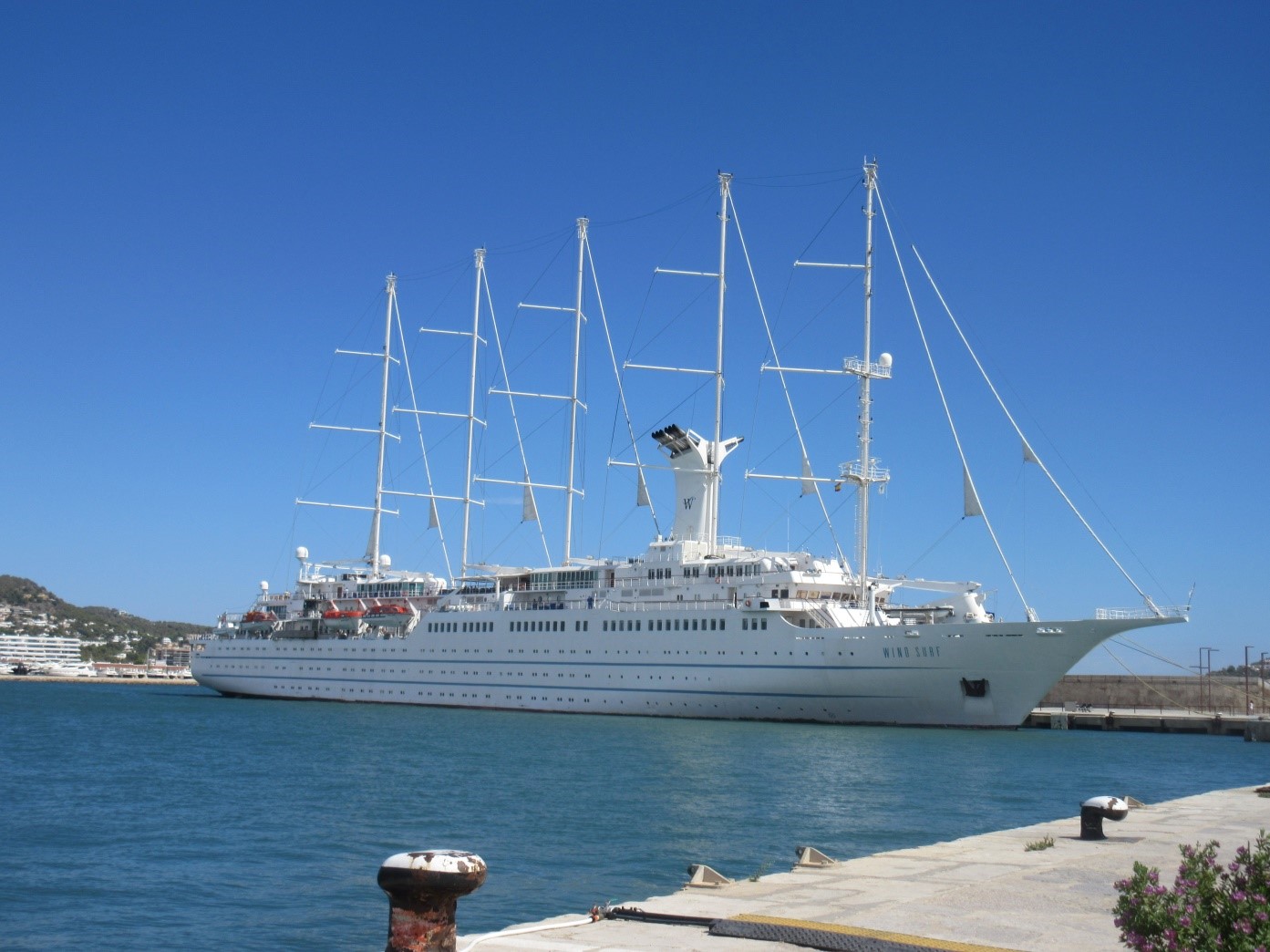
With a day at sea before our first destination I was very quickly thrown into the idea of having guests asking questions on the bridge. It also gave me a good amount of time to learn my way around the bridge equipment, especially the sail controls. During this time I was working with the third officer, and therefore my ‘overtime work’ was made up of the maintenance of LSA, embarkation training, and muster lists. After a week’s familiarisation I was given tasks such as checking and replacing BA bottles after drills, inventories for lifeboats and tenders, checking fire screen doors, testing smoke detectors, and updating muster lists, and let to get on with them. During my second week we also had Port State Inspection, so I often was asked questions to research in SOLAS.
In order to get to know my officers and fellow cadets (all of which I knew through college, but not well) and other crew members, we spent our afternoon exploring some of our destinations. While on 8-12, out ‘overtime work’ was carried out from half 12 till half 2, giving a good couple of hours to explore, spend time on the ship water sports platform, or rest, in the afternoon.
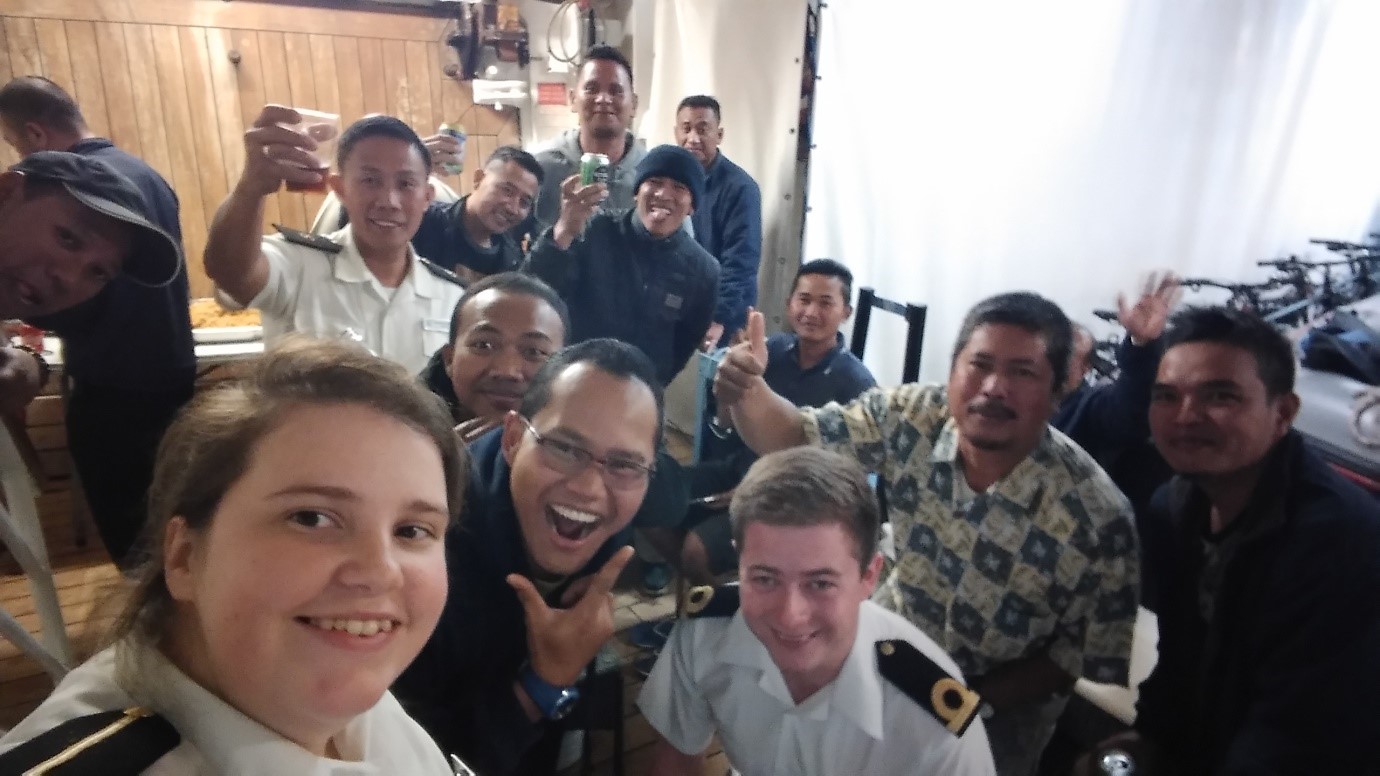
After my fifth cruise I changed watch to the 4-8, with the positive note of getting to experience arrivals and departures, getting to work more with the sails and their maintenance, being a larger presence in crew training. At first I was not looking forward to waking up so early, but soon realised I actually preferred getting up for 4 then I did for 8! On this watch there would be the more or less same routine most days. Getting up as quietly as possible & getting ready in the dark in order to not disturb my cabin mate between 0315 and 0330, stopping by my best friend on board who was on night duty in reception to wake up a bit, getting on to the bridge for around 0340-0345 and making a coffee, After the watch was handed over, Second Officer Aline, QM Rosid, and I would walk something like 70 laps of the bridge (about a mile) if safe to do so, while discussing mostly travels, adventures and near death experiences, an hour before the pilot we would start our pre-arrival checks, such as calling arrival parties, contacting the port and/or pilots, making sure all is in order for the Captain to take the vessels control. On arrival I was in charge of fixing positions, the arrival checklist and the rough log. Usually by time we were alongside and moored it was about time to hand over the watch, and have an hour or so nap before starting the days out of watch work, be that sails or training, followed by lunch (usually ashore) and an explore/nap/study before returning to the bridge at 1600.
Sails maintenance included routine checks such a movements and mast inspections, emergency maintenance such as repairs, and general upkeep such as greasing and topping up oil. It became noticeable one day that our fifth main sail had a small vertical tear, which resulted in spending our Halloween morning with a team of sailors, lowering the sail and sewing a patch on either side to cover the hole. I did get a little worried after proudly exclaiming that I had help sew the patch, that it would come loose and the rip becoming visible again. Both our QM Rosid and 2/O Aline both went up the top of the masts, which I would have loved to do, but due to insurance I wasn’t allowed. Most sails days we did end up greasy, oily, mucky, sweaty and tired, but it was such a great learning experience and I so much enjoyed the hands on element.
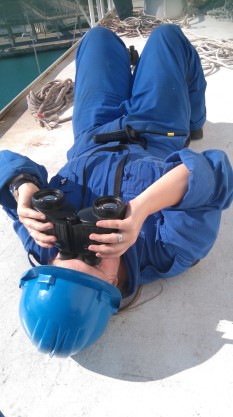
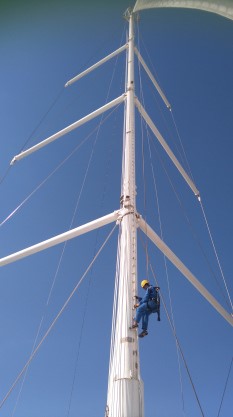
Training was also such a brilliant thing to get involved in, as I was able to see things we’d talked about at college happen on location, and I got the practical side of things. Some trainings included just discussing first response in the crew specific locations, some presentations, some drills, but my favourite were definitely ones that broke down what we would do in an emergency while still carried out the actions, such as the day we inflated a life raft on the quay side and in groups got the whole crew inside so they saw how crowded it was and what you would do, but the best and worse at the same time was fire team training. During this the fire team, and usually myself, would dress up fully in firefighting gear, practice using a fire hose from the aft mooring deck, then practice entering a smoke filled/dark area retrieving a casualty and putting a ‘fire’ out”.
At the end of the Mediterranean Season we went in to Cadiz Dry dock for two weeks, having already been in dry dock in my first phase I was well and truly not looking forward to this, however looking back on the time spent I enjoyed my time and found it extremely valuable The idea of day work also threw my body a bit, after weeks of 4 and 8s, working from 0730 through to 2015, with lunch & dinner breaks did take a few days to get used to. Every day was busy, I was tired, I ended up very sweaty every day, I got stressed,(as was everyone on board) I loved it, maybe not at the time (or at least most of the time), but looking back I know I enjoyed the work, and I really appreciate the responsibilities that I was given.
My main role during dry dock, and partially during wet dock was ‘Fire Guard Cadet’ along with GSM Anthony ‘Fire Guard Supervisor’, we assigned pairs, originally known as fire guards but later Fireflies, to a hot work, and check on them throughout the day, refilled their bottles if needed, etc. Each day we must have walked miles just making rounds of the ship. Some days there were more hot work locations then teams, which meant I stepped up to the role of fire guard. Other tasks I was involved in during the two weeks included assisting in the preparation of Permits to Work, being first response for fire alarms, working with the ETO, being outside of tank entries in case of emergency and continuing maintenance of firefighting equipment, and sail system.
The best days in Dry dock were the days that I was allowed to go into the dock itself. The first I tagged along with 2/O Aline within a few days of arriving, second with most of the crew, mid-way through the two weeks, and finally a couple of days before we left, I was tasked on supervising a contractor doing some work on the echo sounder anodes. It was really interesting seeing how the ship looked during the whole time, before and after, in comparison to embarking late in to dry dock like on Commodore Goodwill.
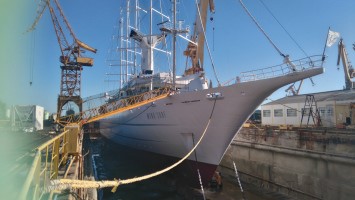
Once Dry Dock was completed we started out crossing to the Caribbean, the ship was still in maintenance mode and was known as ‘Wet Dock’. Wet dock was a complete different work schedule, paired with the constant clock changes (retarding an hour every few days), my body clock did feel a wee bit out of whack. During our two weeks crossing I was on watch on the bridge between 0400 and 0800, though I prepped the days permits to work, so often didn’t leave the bridge till 0830ish, then 0845-0900 I would join the sailors in working around the ship, finishing just after 1500 each day. The reason for this was that both the other deck cadet, Alistair, and I could both do a navigational watch in which the sun was rising or setting, in order to practice our celestial navigation, along with completely practical maintenance tasks.
Each morning I would estimate a position for civil twilight (when you can see the horizon and stars) that day position using a previous and distance = speed x times. I would then find an estimation of where in the sky recognisable stars would be at that time. When said time comes around I’d use a sextant and azimuth ring to find the bearing and amplitude of the stars, of which I used to plot the ships position on the chart. During the day I partook in tasks such as wash downs of the ship, making sure things were back in shape for arrival in St. Maarten, repairing and pressure testing fire hoses, working with the Carpenters, and continuing the general upkeep and maintenance of LSA, Lifeboats and Tenders, the sail system.
We arrived at Philipsburg, St. Maaten at the start of December, having stopped off in St. John’s, Antigua to dispose of garbage, pick up some embarking crew. I returned to being on 4-8 full time, however this time with 2/O Sebastian, however after the first week, Alistair disembarked, leaving me as the only deck cadet on board, so did work with each of the navigating officers, if and when required.
During watches my 2/O took a step back and it became more like him shadowing me as to oppose to me shadowing him. He was very reassuring that he was there if I had any uncertainties, to ask away, but soon I’ll be qualified and need to be confident having the con, so good to have some practice with someone there. Throughout watches he’d also ask me question such as what action I think we should take when we sighted other vessels, reinforcing my rules of the road practically. Along with often leaving the pre-arrival/pre-departure checks down to me, though doesn’t seem like much, it worked wonders for me feeling confident about being a future officer.
With work being done on the sails infrastructure during wet and dry dock, and Sebastian’s duo-ticket, the maintenance we did on sails was different to what was done with Aline. My last few weeks on sails were spent concentrating on the workings of the system and trying to restore them to a near original condition.
During the Caribbean season I became more aware of other operations that happened around the vessel, each cruise the chief officer, invited me to host tables with him in the guest dining room, I had time and energy to attend the on Deck BBQs & Line Dancing, beach BBQs, I spent time at the Marina, and I also managed to watch the crew show. I even sang Christmas carols on Christmas eve to our guests, and spent my New Year’s Eve interacting with guests in the Compass Rose bar. By this time this had come around I was very used to interacting with guests, giving them tours of the bridge, answering any questions, but hosting tables was something different, every time I felt terrified (normally only for the first 10 minutes or so), I really didn’t want to say the wrong with, or worse spill food on my formal whites! Luckily, I got on very well with my chief officer, so my mind was put at rest, and it was very easy to continue a conversation.
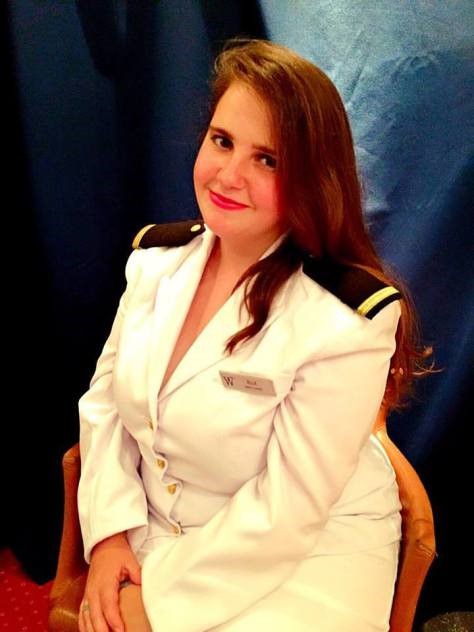
I feel that am very lucky to have sailed with Captain Gerard and his wonderful team. Everybody on board taught me something, and I have made some fantastic friends that I hope I do stay in contact with. I feel completely privileged to work with who I have, and glad for the experience. I really did not want to leave, and genuinely felt home sick for the first time ever once I returned home.
After some time at home I flew out to Star Legend in Puerto Rico. I spent the my first couple of weeks working with the sailors, given tasks by the bosun, this was much like the work I was doing during Wet Dock. Before going on to the 12-4 watch working with the Navigational Officer 2/O Nazly. Nazly had full trust in me and let me take the watch as soon as I started on watch with her, showing me all the controls and equipment on the bridge, and quizzing me on Rules of the road and other thing I’d need to know for my final exams. Many of the operations were similar to those onboard the Wind Surf.
During my overtime time with Nazly our tasks included routine planned maintenance and emergency maintenance on the fixed firefighting appliances and flexi flog systems, along with planning the routes for the upcoming trips and updating navigational equipment such as the ECDIS, paper charts and publications.
I stayed on the 12-4 watch from starting watching in March till the end of May, all but one of these weeks I was working with Nazly, however when she was promoted to chief officer, I stayed on the 12-4 to help newly promoted Kris to settle in and learn the job. As Kris did not get a hand over from an officer of the same rank he had become, in my last few weeks with Nazly she handed over to me and taught me how to carry out all the tasks in which she did in order to teach Kris. During this time we were mostly sailing around the Caribbean, before crossing to the Med. This crossing was completely different to that I had done before, as we had guests on board, who regularly visited the Bridge, either for general visits and asking how far we had gone, or to attend any of the set talks put on for them, ones in which I instructed were chart reading and knot tying. My last few weeks on Star Legend I changed to the 8-12 watch in order to help the newly qualified third officer settle in, assisting him with navigational watches and planned maintenance of Life Saving Appliances.